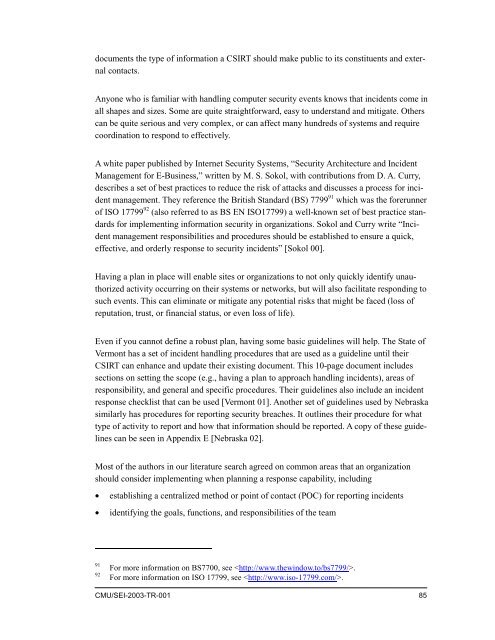State of the Practice of Computer Security Incident Response Teams ...
State of the Practice of Computer Security Incident Response Teams ...
State of the Practice of Computer Security Incident Response Teams ...
You also want an ePaper? Increase the reach of your titles
YUMPU automatically turns print PDFs into web optimized ePapers that Google loves.
documents <strong>the</strong> type <strong>of</strong> information a CSIRT should make public to its constituents and external<br />
contacts.<br />
Anyone who is familiar with handling computer security events knows that incidents come in<br />
all shapes and sizes. Some are quite straightforward, easy to understand and mitigate. O<strong>the</strong>rs<br />
can be quite serious and very complex, or can affect many hundreds <strong>of</strong> systems and require<br />
coordination to respond to effectively.<br />
A white paper published by Internet <strong>Security</strong> Systems, “<strong>Security</strong> Architecture and <strong>Incident</strong><br />
Management for E-Business,” written by M. S. Sokol, with contributions from D. A. Curry,<br />
describes a set <strong>of</strong> best practices to reduce <strong>the</strong> risk <strong>of</strong> attacks and discusses a process for incident<br />
management. They reference <strong>the</strong> British Standard (BS) 7799 91 which was <strong>the</strong> forerunner<br />
<strong>of</strong> ISO 17799 92 (also referred to as BS EN ISO17799) a well-known set <strong>of</strong> best practice standards<br />
for implementing information security in organizations. Sokol and Curry write “<strong>Incident</strong><br />
management responsibilities and procedures should be established to ensure a quick,<br />
effective, and orderly response to security incidents” [Sokol 00].<br />
Having a plan in place will enable sites or organizations to not only quickly identify unauthorized<br />
activity occurring on <strong>the</strong>ir systems or networks, but will also facilitate responding to<br />
such events. This can eliminate or mitigate any potential risks that might be faced (loss <strong>of</strong><br />
reputation, trust, or financial status, or even loss <strong>of</strong> life).<br />
Even if you cannot define a robust plan, having some basic guidelines will help. The <strong>State</strong> <strong>of</strong><br />
Vermont has a set <strong>of</strong> incident handling procedures that are used as a guideline until <strong>the</strong>ir<br />
CSIRT can enhance and update <strong>the</strong>ir existing document. This 10-page document includes<br />
sections on setting <strong>the</strong> scope (e.g., having a plan to approach handling incidents), areas <strong>of</strong><br />
responsibility, and general and specific procedures. Their guidelines also include an incident<br />
response checklist that can be used [Vermont 01]. Ano<strong>the</strong>r set <strong>of</strong> guidelines used by Nebraska<br />
similarly has procedures for reporting security breaches. It outlines <strong>the</strong>ir procedure for what<br />
type <strong>of</strong> activity to report and how that information should be reported. A copy <strong>of</strong> <strong>the</strong>se guidelines<br />
can be seen in Appendix E [Nebraska 02].<br />
Most <strong>of</strong> <strong>the</strong> authors in our literature search agreed on common areas that an organization<br />
should consider implementing when planning a response capability, including<br />
• establishing a centralized method or point <strong>of</strong> contact (POC) for reporting incidents<br />
• identifying <strong>the</strong> goals, functions, and responsibilities <strong>of</strong> <strong>the</strong> team<br />
91<br />
92<br />
For more information on BS7700, see .<br />
For more information on ISO 17799, see .<br />
CMU/SEI-2003-TR-001 85
















